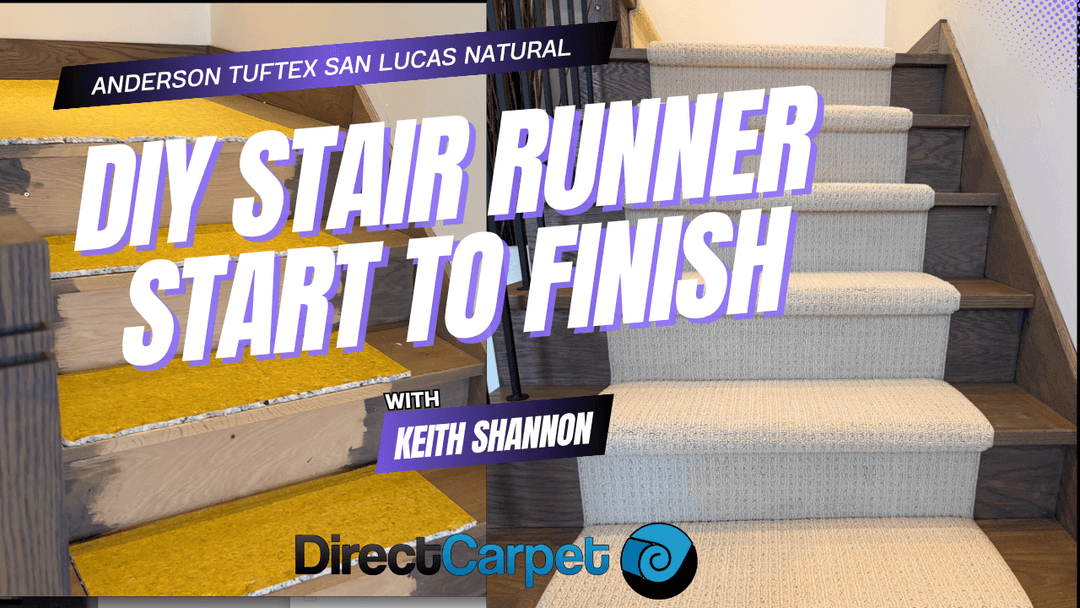How Long Should My Stair Runner Be to Fit My Stairs?
🚀 The Ultimate Guide: How Long Should a Stair Runner Be?

📊 By Keith Shannon – Professional Stair Runner Installer (25+ Years), Founder of DirectCarpet.com
Getting the right stair runner length is crucial for safety, style, and a professional finish. Whether your stairs are straight, curved, or include landings, the right measurements make all the difference. ✅
Quick Answers: Stair Runner Length by Stair Count
| 🏠 Number of Stairs | 📏 Runner Length Needed |
|---|---|
| 6 Stairs | 11 Feet |
| 7 Stairs | 12 Feet |
| 8 Stairs | 14 Feet |
| 9 Stairs | 15 Feet |
| 10 Stairs | 17 Feet |
| 11 Stairs | 19 Feet |
| 12 Stairs | 20 Feet |
| 13 Stairs | 22 Feet |
| 14 Stairs | 24 Feet |
| 15 Stairs | 25 Feet |
| 16 Stairs | 27 Feet |
| 17 Stairs | 28 Feet |
Pro Tip: Always round up to the nearest foot for complete coverage!
🛠️ How to Measure Your Stairs
Step 1: Count Your Stairs
Don’t forget the top riser. Example: 12 stairs = 12.5 stairs of coverage.
Step 2: Use the Formula
(Number of stairs × 19 inches) ÷ 12 = total feet needed
Example: 12.5 stairs × 19 ÷ 12 = 19.8 ft → round up to 20 ft.
Step 3: Account for Extras
- 🌀 Curved Stairs: Add extra for proper fit.
- 🛤 Landings: Include landing coverage.
- 🎨 Patterned Runners: Order extra for pattern matching.
📐 Standard Widths vs. Custom Sizing
| Type | Common Widths |
|---|---|
| Machine-Made | 27" , 30" , 36" |
| Custom | Any width you need |
Pro Tip: Leave 3–12 inches of stair exposed on each side for the best look.
🔧 DIY vs. Professional Install
| Installation Type | Best For |
|---|---|
| DIY Install | Straight staircases ✅ |
| Professional Install | Curved/complex stairs ✅ |
🏆 Best Materials for Stair Runners
| Material | Durability | Recommended? |
|---|---|---|
| Wool | High | Yes ✅ |
| Nylon | High | Yes ✅ |
| Polyester | Medium | No ❌ |
| Olefin | Low | No ❌ |
❓ FAQs: Stair Runner Length
How long should a stair runner be for 12 stairs?
For 12 stairs, you’ll need about 20 feet of runner length.
What’s the formula to calculate stair runner length?
(Number of stairs × 19 inches) ÷ 12 = total feet needed. Always round up.
Do I need extra material for patterns or landings?
Yes ✅ – always add 1–2 feet extra to ensure proper alignment and full coverage.
🚀 Final Word
✅ Count your stairs correctly
✅ Use the formula to calculate length
✅ Add extra for landings & patterns
✅ Choose the right width and durable material
✅ Consider pro install for curved stairs
🎯 Ready to order your perfect fit? Shop the full Stair Runner Collection today or use our free Stair Runner Calculator to measure instantly.
Getting the right stair runner length is crucial for safety, style, and a professional finish. Whether your stairs are straight, curved, or include landings, the right measurements make all the difference. Need help installing it afterward? Check out our step-by-step installation guide to complete the job like a pro.
Quick Answers: Stair Runner Length by Stair Count
| Number of Stairs | Runner Length Needed |
|---|---|
| 6 Stairs | 11 ft |
| 7 Stairs | 12 ft |
| 8 Stairs | 14 ft |
| 9 Stairs | 15 ft |
| 10 Stairs | 17 ft |
| 11 Stairs | 19 ft |
| 12 Stairs | 20 ft |
| 13 Stairs | 22 ft |
| 14 Stairs | 24 ft |
| 15 Stairs | 25 ft |
| 16 Stairs | 27 ft |
| 17 Stairs | 28 ft |










Leave a comment